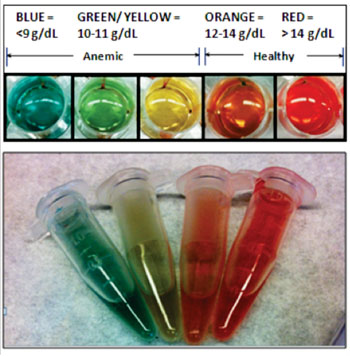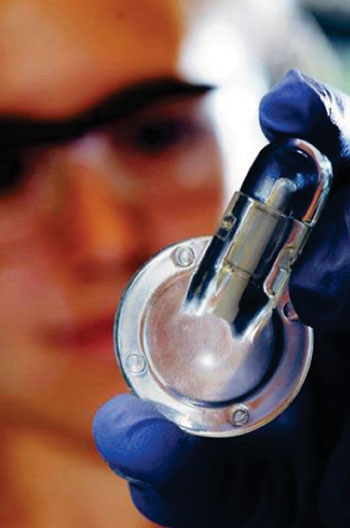New Point of Care Test for Anemia Developed
|
By LabMedica International staff writers Posted on 19 May 2015 |

Image: The AnemoCheck point-of-care test for hemoglobin (Photo courtesy of Erika Tyburski).

Image: The pre-filled larger tube component of the AnemoCheck point-of-care test for hemoglobin (Photo courtesy of Emory University).
New diagnostic technology may shift some hemoglobin testing for anemia out of clinical laboratories and into near-patient settings and it may also be possible to use this new diagnostic device for patient self-testing.
The new diagnostic test has many advantages over the conventional hematological tests done in clinics, hospital laboratories, and free-standing medical laboratories operating expensive laboratory analyzers as it requires no power source, and the results are available within one minute.
The new medical laboratory test is called AnemoCheck and was developed by scientists and students at Emory University (Atlanta, GA, USA), Children’s Healthcare of Atlanta (GA, USA) and the Georgia Institute of Technology (Atlanta, GA). A startup company called Sanguina will create the market for this new test and will operate out of Atlanta (GA, USA).
Each AnemoCheck point-of-care test kit enables patients to check hemoglobin levels by simply pricking their finger to draw 5 μL of blood into a capillary tube, inserting that tube into a larger tube with a pre-filled chemical solution, mixing, waiting one minute, and assessing the color change of the solution using a reference color scale card included with the kit. The hemoglobin present in the blood acts as a catalyst for a reduction-oxidation reaction and within approximately 45 seconds, a color change occurs. Ideally, the test would be able to subjectively differentiate low, medium and high levels of hemoglobin to diagnose anemia at home.
The user compares the solution in the tube to the color-scale card that comes with the kit. The color ranges from green-blue to red depending on the severity of anemia. Readings can be sent to a Smartphone application (app) for interpretation, storage, and sharing. The test is very convenient as AnemoCheck eliminates the need for repeated trips to clinical laboratories for the chronically ill or for patients who must travel great distances to reach medical facilities.
Erika Tyburski, BS, who developed the AnemoCheck, said, “Results indicate that AnemoCheck can detect even the mildest form of anemia across many different etiologies with sensitivity of more than 90% and specificity of more than 79%. We are currently planning beta testing for home-validation in a sickle cell disease user group that will gauge the ease of use and likelihood of adoption within this group. We do not intend to replace clinical testing, but supplement it to offer piece of mind, and potentially screen for changes in hemoglobin prior to disease-specific crises.”
Related Links:
Emory University
Children’s Healthcare of Atlanta
Georgia Institute of Technology
The new diagnostic test has many advantages over the conventional hematological tests done in clinics, hospital laboratories, and free-standing medical laboratories operating expensive laboratory analyzers as it requires no power source, and the results are available within one minute.
The new medical laboratory test is called AnemoCheck and was developed by scientists and students at Emory University (Atlanta, GA, USA), Children’s Healthcare of Atlanta (GA, USA) and the Georgia Institute of Technology (Atlanta, GA). A startup company called Sanguina will create the market for this new test and will operate out of Atlanta (GA, USA).
Each AnemoCheck point-of-care test kit enables patients to check hemoglobin levels by simply pricking their finger to draw 5 μL of blood into a capillary tube, inserting that tube into a larger tube with a pre-filled chemical solution, mixing, waiting one minute, and assessing the color change of the solution using a reference color scale card included with the kit. The hemoglobin present in the blood acts as a catalyst for a reduction-oxidation reaction and within approximately 45 seconds, a color change occurs. Ideally, the test would be able to subjectively differentiate low, medium and high levels of hemoglobin to diagnose anemia at home.
The user compares the solution in the tube to the color-scale card that comes with the kit. The color ranges from green-blue to red depending on the severity of anemia. Readings can be sent to a Smartphone application (app) for interpretation, storage, and sharing. The test is very convenient as AnemoCheck eliminates the need for repeated trips to clinical laboratories for the chronically ill or for patients who must travel great distances to reach medical facilities.
Erika Tyburski, BS, who developed the AnemoCheck, said, “Results indicate that AnemoCheck can detect even the mildest form of anemia across many different etiologies with sensitivity of more than 90% and specificity of more than 79%. We are currently planning beta testing for home-validation in a sickle cell disease user group that will gauge the ease of use and likelihood of adoption within this group. We do not intend to replace clinical testing, but supplement it to offer piece of mind, and potentially screen for changes in hemoglobin prior to disease-specific crises.”
Related Links:
Emory University
Children’s Healthcare of Atlanta
Georgia Institute of Technology
Latest Hematology News
- New Scoring System Predicts Risk of Developing Cancer from Common Blood Disorder
- Non-Invasive Prenatal Test for Fetal RhD Status Demonstrates 100% Accuracy
- WBC Count Could Predict Severity of COVID-19 Symptoms
- New Platelet Counting Technology to Help Labs Prevent Diagnosis Errors
- Streamlined Approach to Testing for Heparin-Induced Thrombocytopenia Improves Diagnostic Accuracy
- POC Hemostasis System Could Help Prevent Maternal Deaths
- New Test Assesses Oxygen Delivering Ability of Red Blood Cells by Measuring Their Shape
- Personalized CBC Testing Could Help Diagnose Early-Stage Diseases in Healthy Individuals
- Non-Invasive Test Solution Determines Fetal RhD Status from Maternal Plasma
- First-Of-Its-Kind Smartphone Technology Noninvasively Measures Blood Hemoglobin Levels at POC

- Next Gen CBC and Sepsis Diagnostic System Targets Faster, Earlier, Easier Results
- Newly Discovered Blood Group System to Help Identify and Treat Rare Patients
- Blood Platelet Score Detects Previously Unmeasured Risk of Heart Attack and Stroke
- Automated Benchtop System to Bring Blood Testing To Anyone, Anywhere
- New Hematology Analyzers Deliver Combined ESR and CBC/DIFF Results in 60 Seconds
- Next Generation Instrument Screens for Hemoglobin Disorders in Newborns
Channels
Clinical Chemistry
view channel
Mass Spectrometry-Based Monitoring Technique to Predict and Identify Early Myeloma Relapse
Myeloma, a type of cancer that affects the bone marrow, is currently incurable, though many patients can live for over 10 years after diagnosis. However, around 1 in 5 individuals with myeloma have a high-risk... Read more
‘Brilliantly Luminous’ Nanoscale Chemical Tool to Improve Disease Detection
Thousands of commercially available glowing molecules known as fluorophores are commonly used in medical imaging, disease detection, biomarker tagging, and chemical analysis. They are also integral in... Read more
Low-Cost Portable Screening Test to Transform Kidney Disease Detection
Millions of individuals suffer from kidney disease, which often remains undiagnosed until it has reached a critical stage. This silent epidemic not only diminishes the quality of life for those affected... Read more
New Method Uses Pulsed Infrared Light to Find Cancer's 'Fingerprints' In Blood Plasma
Cancer diagnoses have traditionally relied on invasive or time-consuming procedures like tissue biopsies. Now, new research published in ACS Central Science introduces a method that utilizes pulsed infrared... Read moreMolecular Diagnostics
view channel
Genetic-Based Tool Predicts Survival Outcomes of Pancreatic Cancer Patients
A tumor marker is a substance found in the body that may signal the presence of cancer. These substances, which can include proteins, genes, molecules, or other biological compounds, are either produced... Read more
Urine Test Diagnoses Early-Stage Prostate Cancer
Prostate cancer is one of the leading causes of death among men worldwide. A major challenge in diagnosing the disease is the absence of reliable biomarkers that can detect early-stage tumors.... Read moreImmunology
view channel
Stem Cell Test Predicts Treatment Outcome for Patients with Platinum-Resistant Ovarian Cancer
Epithelial ovarian cancer frequently responds to chemotherapy initially, but eventually, the tumor develops resistance to the therapy, leading to regrowth. This resistance is partially due to the activation... Read more
Machine Learning-Enabled Blood Test Predicts Immunotherapy Response in Lymphoma Patients
Chimeric antigen receptor (CAR) T-cell therapy has emerged as one of the most promising recent developments in the treatment of blood cancers. However, over half of non-Hodgkin lymphoma (NHL) patients... Read moreMicrobiology
view channel
New Test Diagnoses Bacterial Meningitis Quickly and Accurately
Bacterial meningitis is a potentially fatal condition, with one in six patients dying and half of the survivors experiencing lasting symptoms. Therefore, rapid diagnosis and treatment are critical.... Read more
Handheld Device Delivers Low-Cost TB Results in Less Than One Hour
Tuberculosis (TB) remains the deadliest infectious disease globally, affecting an estimated 10 million people annually. In 2021, about 4.2 million TB cases went undiagnosed or unreported, mainly due to... Read more
New AI-Based Method Improves Diagnosis of Drug-Resistant Infections
Drug-resistant infections, particularly those caused by deadly bacteria like tuberculosis and staphylococcus, are rapidly emerging as a global health emergency. These infections are more difficult to treat,... Read more
Breakthrough Diagnostic Technology Identifies Bacterial Infections with Almost 100% Accuracy within Three Hours
Rapid and precise identification of pathogenic microbes in patient samples is essential for the effective treatment of acute infectious diseases, such as sepsis. The fluorescence in situ hybridization... Read morePathology
view channel
AI-Based Model Predicts Kidney Cancer Therapy Response
Each year, nearly 435,000 individuals are diagnosed with clear cell renal cell carcinoma (ccRCC), making it the most prevalent subtype of kidney cancer. When the disease spreads, anti-angiogenic therapies... Read more
Sensitive and Specific DUB Enzyme Assay Kits Require Minimal Setup Without Substrate Preparation
Ubiquitination and deubiquitination are two important physiological processes in the ubiquitin-proteasome system, responsible for protein degradation in cells. Deubiquitinating (DUB) enzymes contain around... Read moreTechnology
view channel
Light Signature Algorithm to Enable Faster and More Precise Medical Diagnoses
Every material or molecule interacts with light in a unique way, creating a distinct pattern, much like a fingerprint. Optical spectroscopy, which involves shining a laser on a material and observing how... Read more
Disposable Microchip Technology Could Selectively Detect HIV in Whole Blood Samples
As of the end of 2023, approximately 40 million people globally were living with HIV, and around 630,000 individuals died from AIDS-related illnesses that same year. Despite a substantial decline in deaths... Read more
Pain-On-A-Chip Microfluidic Device Determines Types of Chronic Pain from Blood Samples
Chronic pain is a widespread condition that remains difficult to manage, and existing clinical methods for its treatment rely largely on self-reporting, which can be subjective and especially problematic... Read more
Innovative, Label-Free Ratiometric Fluorosensor Enables More Sensitive Viral RNA Detection
Viruses present a major global health risk, as demonstrated by recent pandemics, making early detection and identification essential for preventing new outbreaks. While traditional detection methods are... Read moreIndustry
view channel
Cepheid and Oxford Nanopore Technologies Partner on Advancing Automated Sequencing-Based Solutions
Cepheid (Sunnyvale, CA, USA), a leading molecular diagnostics company, and Oxford Nanopore Technologies (Oxford, UK), the company behind a new generation of sequencing-based molecular analysis technologies,... Read more
Grifols and Tecan’s IBL Collaborate on Advanced Biomarker Panels
Grifols (Barcelona, Spain), one of the world’s leading producers of plasma-derived medicines and innovative diagnostic solutions, is expanding its offer in clinical diagnostics through a strategic partnership... Read more

















